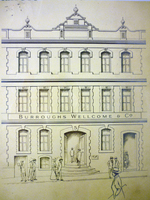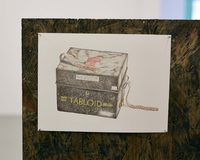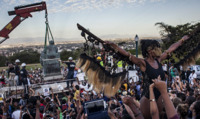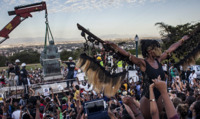Items
Site
The Medicine Chest
keywords is exactly
hunting
-

A1.44.
The contents of Floyd’s two travelling cases for his hunting trip (BC666 A1.44. Special Collections, University of Cape Town). -

BWC Cape Town premises
"When Burroughs died of pneumonia in 1895, Wellcome became BWC’s sole owner, and the next 20 years (until the outbreak of World War I) constituted a period of massive expansion for the company (Bailey 2008: online). In 1898, the first overseas branch opened in Sydney and was followed by seven more branches – in New York, Montreal, Buenos Aires, Cape Town, Milan, Shanghai and Bombay – by 1912. The Cape Town branch opened in 1902, seven years after Wellcome made his first visit to the city in 1895" (Liebenberg 2021: 49 - 51). -

BWC Cape Town premises (drawing)
Line drawing of the Burroughs Wellcome & Co. office, Cape Town, South Africa. -

The Landis Museum
A drawing by the artist-curator James Hutchinson (Chapter Thirteen) based on an audio description of the object as art of the Glasgow International Arts festival. "Nina Liebenberg also undertakes a form of object analysis at an institutional border. She spent an afternoon in the strongroom of the University of Cape Town's special collections department, examining an early 20th century medicine box commissioned for a hunting trip in (then) Northern Rhodesia. Such boxes had been essential parts of the British colonial project, and allowed emigres, missionaries and explorers to venture deeper into unknown territory without fear of contracting tropical diseases. Liebenberg’s report from the strongroom acts as a set of instructions for The Landis Museum’s curator to make a drawing of the box, to which he has no physical access". Extract from the 'Exhibition Guide' of the Landis Museum (Chapter Thirteen), Glasgow International Arts Festival, 20 April - 07 May 2018. -

Floyd in Northern Rhodesia
"In 1913, Walter Floyd undertook a hunting trip with a few of his friends to (then) Northern Rhodesia. It was prior to embarking on this trip, that he purchased the No. 254 medicine chest in the Burroughs Wellcome & Co shop in Cape Town. "With the exception of an occasional Portuguese explorer, the area that became known as Rhodesia lay largely untouched by Western intervention until the mid-19th century. It was only after 1851, when the Scottish missionary and explorer David Livingstone entered this terrain, that accounts of it spread to London and further afield (Taylor 2006: 11). However, a significant number of explorers, missionaries and traders began to arrive in the region after the Berlin Conference (1884–1885) (Simson 1985: 7), and in 1890 Cecil John Rhodes, spearheading British imperial interests in the area, secured, through trickery and deception, exclusive mining concessions from the local chiefs for the British South Africa Company (Taylor 2006: 11). By 1895, the area, now renamed Northern and Southern Rhodesia after Rhodes, was proclaimed a British sphere of influence" (Liebenberg 2021: 57) -

Chapunga - The day Rhodes fell
The character Msezane is portraying depicts the statue of the Zimbabwe bird that was wrongfully appropriated from Great Zimbabwe by the British colonialist Cecil Rhodes. It currently sits in his Groote Schuur estate.


